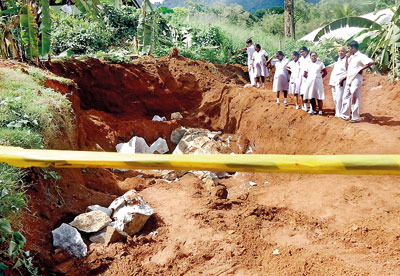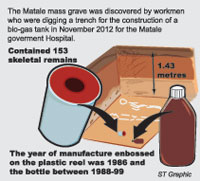News
JVP has bones to pick with then-UNP govt. as graves date to ’86-’89 period
View(s):Past hospital employees disclaim extra-judicial killings as Army plays holier than thou while awaiting outcome of postmortem, forensic investigations
By Leon Berenger
Reports by experts on the findings of the mass grave at Matale last week, has drawn mixed reactions from the relevant authorities and political parties, but the mystery remains unsolved, pending a court decision. The grave situated in the backyard of the Matale Government Hospital, was discovered by labourers digging a trench for the construction of a bio-gas tank, on November 26 last year. It contained 153 skeletal remains.

This week, an archaeological and forensic expert confirmed that the grave dated back to between 1986 and 1989.
The find, which is the single largest mass grave found anywhere in the country, led to wild speculations, with some claiming that the remains were victims of a smallpox epidemic nearly 75 years ago, or the victims of extra-judicial killings during the Janatha Vimukthi Perumana (JVP) insurrection against the State in 1988-89.
It is also known that the Army maintained a small unit in wards 11 and 12, in close vicinity to the hospital’s Out-Patients Department (OPD), and the gravesite was located close to ward 10 during the reign of terror in the late ’80s. However, this week, an archeological and forensic expert confirmed that the grave dated back between 1986 and 1989, and a 54-page report on his findings was handed over to the regional court.
“I came to this conclusion on material evidence – a bottle and an empty plastic plaster reel that was found inside the grave,” Prof. Raj Somadeva of the Department of Archaeology, Kelaniya University, told the Sunday Times. The year of manufacture endorsed on the plastic reel was 1986 and the bottle between 1988-99, he said, adding that it was the only simple assumption that the victims were buried around the same time in the grave which is approximately 1.43 metres deep.
“However, the cause of death, gender and other details could only be established once a thorough forensic medical investigations is conducted, and commenting on the issue prior to that could lead to complications and misunderstandings,” Prof. Somadeva added.
“At present, we are trying to establish the gender, identification features, age etc., of the remains, which will take some time,” Matale Judicial Medical Officer (JMO) Dr. Ajith Jayasena told the Sunday Times.
He said the preliminary reports carried only the post mortem, which was insufficient to establish the identity, although it is confirmed that the grave existed during the period 1986-1989. He added that, as the DNA testing begins, it was very important for relatives of persons who went missing, to come forward and cooperate in the investigations.

“There may be hundreds of persons in the area, who would have lodged complaints with the local police, regarding persons who went missing during this period, and these individuals should make a conscious effort to come forward and enable us match identifications,” Dr. Jayasena added.
The JVP has already called for an impartial probe into the matter, convinced that the remains belonged to their fighting cadre who were massacred in their thousands, during a harsh crackdown by the then United National Party (UNP) government. Senior JVP Parliamentarian Anura Dissanayake said that a thorough inquiry must be held without delay, and those responsible be punished, irrespective of rank or party affiliations, adding that his party would also take up the matter at international rights forums.
“President Mahinda Rajapaksa who fiercely campaigned for human rights during that period, even speaking at international forums, must act now, to demonstrate that he was sincere in his efforts, or whether it was just for cheap political mileage,” MP Dissanayake added. He said that, in the meantime, the party was collecting its own data and had called for the cooperation of the people in the area towards this end.
“Several parents and relatives of persons who went missing during this period, have already responded, and we hope to use whatever data collected in future DNA tests,” he added. The JVP’s allegations drew sharp criticism from the main opposition UNP who reminded the leftists of the 6,000 plus party supporters, both men and women, who were slain.
The military, for their part, distanced itself from the issue, arguing that, drawing conclusions from a piece of plastic and a bottle is inadequate to confirm the true date and period from when the grave existed.Investigations must go beyond this, such as Carbon 14 testing that would determine the era, and to do this, samples will have to be sent to the United Kingdom or elsewhere, as the country does not have such a facility,” Military Spokesman Brig. Ruwan Wanigasooriya told the Sunday Times.
“It is senseless to even suggest that extra-judicial killings followed by a mass burial took place at this site which is located in the middle of a busy hospital complex where there are scores of patients and hospital staff. If such an activity was to be carried out, there are so many other remote locations in the region,” he said.
However, in the meantime, he stressed that a proper and thorough investigations has to be conducted, as the matter is of a serious nature, and the police will have to conduct such a probe, subject to a court directive. The military opinion was endorsed by a female attendant who worked at the same hospital during this period.
Siddharampillai Manniamma told this paper in an earlier interview late last year, that the Army was present for around three months, but firmly ruled out torture or extra-judicial killings having taken place.
“If that is the case, we would have known, we could have heard gunfire, commotions, but there was nothing like that, although it was known that certain JVP activists were buried at the nearby cemetery situated some 200 metres away from the hospital,” she added.
Her views were shared by L.B. Herath, another minor employee at the same hospital, who said there was no illegal activity during the Army presence at wards 11 and 12.
However, he went on to say that there was a deadly outbreak of smallpox during 1946-47 in the area, when a large number of people perished. “This information was provided by my father who was serving in the hospital as an attendant during this period,” Mr. Herath added.
Follow @timesonlinelk
comments powered by Disqus

















